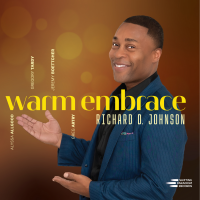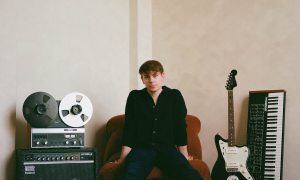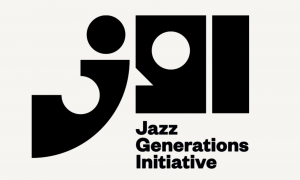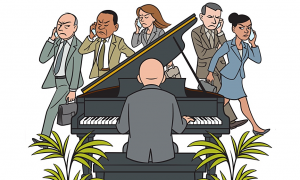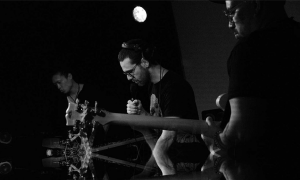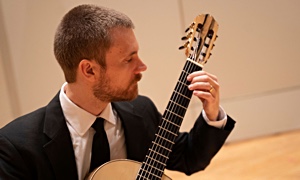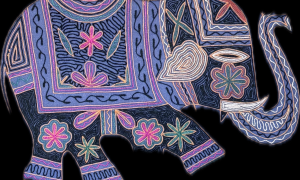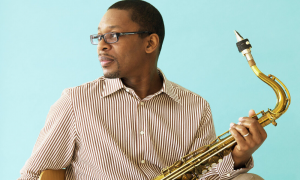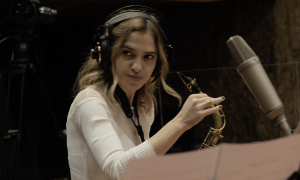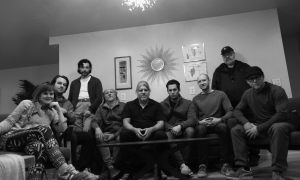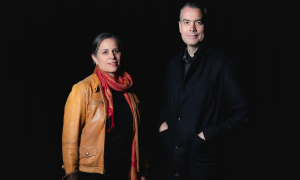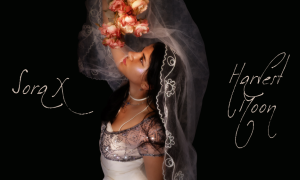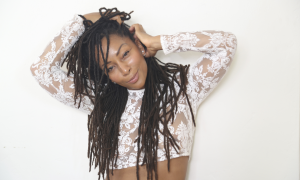
If you're a student of liner notes from the 1950s, the name Anthony Ortega should ring a bell. Anthony played saxophone on a range of well-known recordings during jazz's golden decade, including sessions led by Gigi Gryce, Art Farmer, Quincy Jones, Sonny Stitt, Dinah Washington, Billy Taylor, Nat Pierce, Maynard Ferguson and others. Anthony also led many fabulous recording sessions from the 1950s onward. [Top: Anthony Ortega in high school in the early 1940s, courtesy of Anthony Ortega]
Interestingly, Anthony is one of only a handful of Mexican-Americans who became prominent jazz musicians. Rather than let himself be nudged into Latin bands over the decades, Anthony carved out a niche for himself as a flavorist, most often on alto sax. His tone has a sweet, urgent, pleading edge that was favored by many arrangers. As for his technique, Anthony had the ability to launch effortlessly into lightning-fast improvisational runs.
In Part 1 of my four-part conversation with Anthony Ortega, 83, the saxophonist, clarinetist and flutist talks about growing up on the West Coast and getting his start in music...
JazzWax: Where were you born?
Anthony Ortega: In Los Angeles, in Watts, which is in South Central L.A. I went to grammar school, junior high and high school there. My father was a laborer who worked in a chicken market and did odd jobs. His father had been born in La Paz, Mexico, which is near the tip of the long, thin peninsula on Mexico's western side. My grandfather was a general in Mexico.
JW: And your mom?
AO: My mother was born in El Paso, Texas, but her family traces back to Mexico as well. I have an older brother and sister.
JW: Did you enjoy growing up in Los Angeles in the late '30s and '40s?
AO: I didn't realize it at the time, but it was a great. The city was more rural then. Nearby Orange Country was full of orchards and avocado farms, and there were plenty of rabbits running around.
JW: Were you always interested in music?
AO: Yes. I started by listening to Artie Shaw and Benny Goodman's big bands. I didn't go to concerts. They were too expensive. Most of the music I heard was on the radio. Later on I started buying 78-rpms.
JW: Who first encouraged you to become a musician?
AO: Ray Vasquez, my cousin. He was a good singer and trombonist. We'd always listen to records at his house. He liked Duke Ellington, but I didn't care much for him. The sound of his orchestra was old fashioned to me. It didn't grab me the way Count Basie's and Glenn Miller's [pictured] bands did. Both were well blended and put together in a modern way.
JW: What other records did your cousin play for you?
AO: A lot of discs by tenor saxophonists like Lester Young and Ben Webster. I liked them a lot, too. And Tex Beneke [pictured]. I dug his sunny personality and the way he sang. The way he played his solos were pretty good, too. Now, of course, he sounds a little heavy. But back then, you could really hear the craft. I was obsessed with the saxophone. Eventually my cousin said, “Tell your mom to get you one." So I asked her. She bought me a used alto down at Lockie's Music Exchange in L.A.
JW: Did you go along on that shopping trip?
AO: Oh sure. My cousin came, too, with a friend of his—Maurice Simon, a saxophonist. Maurice was there to test out the instruments. Maurice tried out a couple of altos for me, since a tenor was out of my mother's price range.
JW: Did she buy one for you?
AO: Yes, she bought me a used Conn for $103. It was a good horn, and the salesman said it used to belong to one of Glenn Miller's sax players. That's all I needed to hear. I took really good care of that horn and began to practice with a passion. JW: Did you take lessons?
AO: Not right away. Jordon High School had a solid music program, so I studied there instead of privately. The students were all mixed. There were Mexican, Japanese, black and white kids—and everyone got along. The school had a junior band for students just starting out and then there were different types of bands for more advanced players.
JW: Did you eventually take private lessons?
AO: I took lessons from Lloyd Reese, after my cousin recommended him to me. Reese was a superb trumpeter and saxophonist. He played in swing bands and in the Hollywood studios. He taught everyone coming up. My cousin said, “You're practicing hard and doing a good job, but you need a teacher." I took a streetcar to Reese's home, which was on Maple Street. Lessons were $3 for an hour. I took lessons with him for five years. We worked through Paul de Ville's Universal Method for the Saxophone book from 1908—a classic. Reese also taught me the chord changes to songs.
JW: Were you eager to begin improvising?
AO: Yes. I wanted to start jamming right away. But as I learned all those chord changes, improvising sort of kicked in automatically.
JW: Weren't you distracted in high school?
AO: A little, which made me lax. At one point in1943, Reese started to notice that I wasn't practicing as intensively as I had been. He said, “What happened to you this week, Anthony?" I said, “Well, I've been thinking about going out for the football team." He said, “Do you want to be a football player or saxophonist?" [Photo: Anthony Ortega in high school]
JW: What did you say?
AO: I told him I wanted to think about it. But I knew immediately in my heart that the saxophone was more important to me than football. So I quit the team and devoted the time to practicing a lot more.
JW: Did you own a zoot suit?
AO: Not the full rig, but I had a nice one when I was 16. It was sharkskin with big shoulders and pants draped down. Not extreme.
JW: When did you start playing in groups outside of high school?
AO: In 1943 I was in a band called the Junior Hep Cats, a group of black and Mexican musicians. We once played a high school concert and instead of blowing a lot of notes, I just rode a couple during my solo. Everything thought that was so cool, going the opposite way. I became a star on campus [laughs]. [Photo of Anthony Ortega, bottom right, with the Junior Hep Cats, courtesy of Anthony Ortega]
JW: What was your first paying job as a musician?
AO: That came during the war, in 1944. Friends were jamming on some of Charlie Parker's songs. We decided to form a little group called The Frantic Five. During the war, there was a USO in Watts. Sailors and soldiers went there to dance with the girls on Friday and Saturday nights. Our group got a job there playing for the dancers.
JW: Who wrote your arrangements?
AO: They were mostly head charts. We made about $5 each for playing there. I was 16 years old and still in high school. Once in a while we played somewhere else. When were weren't gigging, we practiced a lot and listened to 78s on a wind-up Victrola.
JW: Why a wind-up?
AO: You could copy a solo by slowing down the tempo with the crank. What you'd hear would be in a different key, of course. But you were able to figure out how the chord intervals ran and the thinking behind the solos. That helped a lot.
JW: Did you continue with music in high school?
AO: Yes. I was selected to be part of the All City Junior High School Orchestra, which gave me exposure to classical music.
JW: Did you study only the saxophone with Reese?
AO: No. After a year of studying, Reese told me that if my ambition was to play in an orchestra, I'd have to double on the clarinet. So I took up the clarinet with him. The clarinet came easy to me. My idols were Benny Goodman and Artie Shaw, and I listened to them a lot. After the clarinet I took up the flute.
JW: Did you own those instruments?
AO: By that time I was earning enough from gigs to put down payments on both. The clarinet was $110, and Reese sold me a flute for $100. I paid in installments.
Tomorrow, a special treat you won't want to miss.
JazzWax clip: Here's Anthony Ortega with Gigi Gryce and Clifford Brown in Paris in October 1953 on Bum's Rush...
Interestingly, Anthony is one of only a handful of Mexican-Americans who became prominent jazz musicians. Rather than let himself be nudged into Latin bands over the decades, Anthony carved out a niche for himself as a flavorist, most often on alto sax. His tone has a sweet, urgent, pleading edge that was favored by many arrangers. As for his technique, Anthony had the ability to launch effortlessly into lightning-fast improvisational runs.
In Part 1 of my four-part conversation with Anthony Ortega, 83, the saxophonist, clarinetist and flutist talks about growing up on the West Coast and getting his start in music...
JazzWax: Where were you born?
Anthony Ortega: In Los Angeles, in Watts, which is in South Central L.A. I went to grammar school, junior high and high school there. My father was a laborer who worked in a chicken market and did odd jobs. His father had been born in La Paz, Mexico, which is near the tip of the long, thin peninsula on Mexico's western side. My grandfather was a general in Mexico.
JW: And your mom?
AO: My mother was born in El Paso, Texas, but her family traces back to Mexico as well. I have an older brother and sister.
JW: Did you enjoy growing up in Los Angeles in the late '30s and '40s?
AO: I didn't realize it at the time, but it was a great. The city was more rural then. Nearby Orange Country was full of orchards and avocado farms, and there were plenty of rabbits running around.
JW: Were you always interested in music?
AO: Yes. I started by listening to Artie Shaw and Benny Goodman's big bands. I didn't go to concerts. They were too expensive. Most of the music I heard was on the radio. Later on I started buying 78-rpms.
JW: Who first encouraged you to become a musician?
AO: Ray Vasquez, my cousin. He was a good singer and trombonist. We'd always listen to records at his house. He liked Duke Ellington, but I didn't care much for him. The sound of his orchestra was old fashioned to me. It didn't grab me the way Count Basie's and Glenn Miller's [pictured] bands did. Both were well blended and put together in a modern way.
JW: What other records did your cousin play for you?
AO: A lot of discs by tenor saxophonists like Lester Young and Ben Webster. I liked them a lot, too. And Tex Beneke [pictured]. I dug his sunny personality and the way he sang. The way he played his solos were pretty good, too. Now, of course, he sounds a little heavy. But back then, you could really hear the craft. I was obsessed with the saxophone. Eventually my cousin said, “Tell your mom to get you one." So I asked her. She bought me a used alto down at Lockie's Music Exchange in L.A.
JW: Did you go along on that shopping trip?
AO: Oh sure. My cousin came, too, with a friend of his—Maurice Simon, a saxophonist. Maurice was there to test out the instruments. Maurice tried out a couple of altos for me, since a tenor was out of my mother's price range.
JW: Did she buy one for you?
AO: Yes, she bought me a used Conn for $103. It was a good horn, and the salesman said it used to belong to one of Glenn Miller's sax players. That's all I needed to hear. I took really good care of that horn and began to practice with a passion. JW: Did you take lessons?
AO: Not right away. Jordon High School had a solid music program, so I studied there instead of privately. The students were all mixed. There were Mexican, Japanese, black and white kids—and everyone got along. The school had a junior band for students just starting out and then there were different types of bands for more advanced players.
JW: Did you eventually take private lessons?
AO: I took lessons from Lloyd Reese, after my cousin recommended him to me. Reese was a superb trumpeter and saxophonist. He played in swing bands and in the Hollywood studios. He taught everyone coming up. My cousin said, “You're practicing hard and doing a good job, but you need a teacher." I took a streetcar to Reese's home, which was on Maple Street. Lessons were $3 for an hour. I took lessons with him for five years. We worked through Paul de Ville's Universal Method for the Saxophone book from 1908—a classic. Reese also taught me the chord changes to songs.
JW: Were you eager to begin improvising?
AO: Yes. I wanted to start jamming right away. But as I learned all those chord changes, improvising sort of kicked in automatically.
JW: Weren't you distracted in high school?
AO: A little, which made me lax. At one point in1943, Reese started to notice that I wasn't practicing as intensively as I had been. He said, “What happened to you this week, Anthony?" I said, “Well, I've been thinking about going out for the football team." He said, “Do you want to be a football player or saxophonist?" [Photo: Anthony Ortega in high school]
JW: What did you say?
AO: I told him I wanted to think about it. But I knew immediately in my heart that the saxophone was more important to me than football. So I quit the team and devoted the time to practicing a lot more.
JW: Did you own a zoot suit?
AO: Not the full rig, but I had a nice one when I was 16. It was sharkskin with big shoulders and pants draped down. Not extreme.
JW: When did you start playing in groups outside of high school?
AO: In 1943 I was in a band called the Junior Hep Cats, a group of black and Mexican musicians. We once played a high school concert and instead of blowing a lot of notes, I just rode a couple during my solo. Everything thought that was so cool, going the opposite way. I became a star on campus [laughs]. [Photo of Anthony Ortega, bottom right, with the Junior Hep Cats, courtesy of Anthony Ortega]
JW: What was your first paying job as a musician?
AO: That came during the war, in 1944. Friends were jamming on some of Charlie Parker's songs. We decided to form a little group called The Frantic Five. During the war, there was a USO in Watts. Sailors and soldiers went there to dance with the girls on Friday and Saturday nights. Our group got a job there playing for the dancers.
JW: Who wrote your arrangements?
AO: They were mostly head charts. We made about $5 each for playing there. I was 16 years old and still in high school. Once in a while we played somewhere else. When were weren't gigging, we practiced a lot and listened to 78s on a wind-up Victrola.
JW: Why a wind-up?
AO: You could copy a solo by slowing down the tempo with the crank. What you'd hear would be in a different key, of course. But you were able to figure out how the chord intervals ran and the thinking behind the solos. That helped a lot.
JW: Did you continue with music in high school?
AO: Yes. I was selected to be part of the All City Junior High School Orchestra, which gave me exposure to classical music.
JW: Did you study only the saxophone with Reese?
AO: No. After a year of studying, Reese told me that if my ambition was to play in an orchestra, I'd have to double on the clarinet. So I took up the clarinet with him. The clarinet came easy to me. My idols were Benny Goodman and Artie Shaw, and I listened to them a lot. After the clarinet I took up the flute.
JW: Did you own those instruments?
AO: By that time I was earning enough from gigs to put down payments on both. The clarinet was $110, and Reese sold me a flute for $100. I paid in installments.
Tomorrow, a special treat you won't want to miss.
JazzWax clip: Here's Anthony Ortega with Gigi Gryce and Clifford Brown in Paris in October 1953 on Bum's Rush...
This story appears courtesy of JazzWax by Marc Myers.
Copyright © 2025. All rights reserved.













